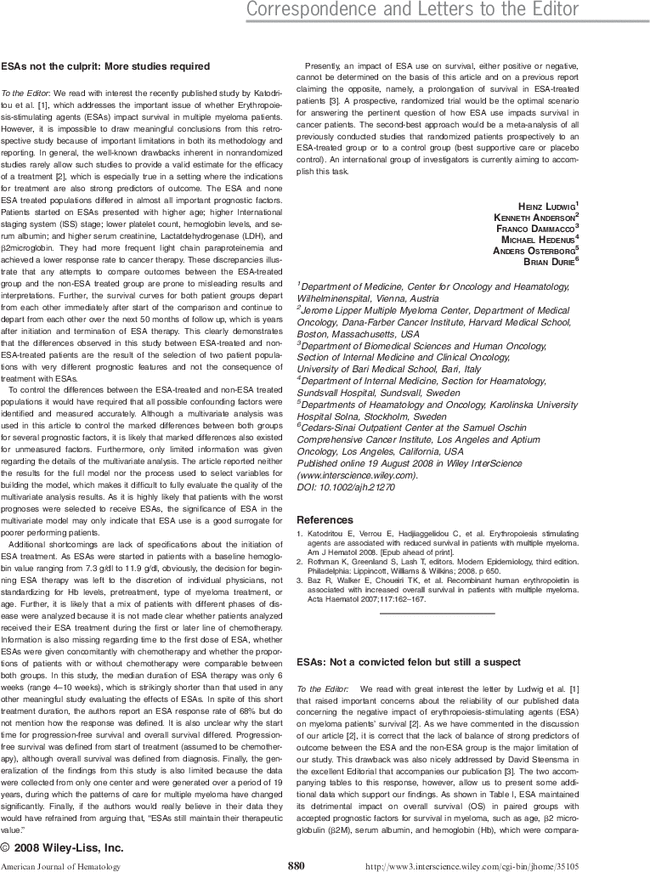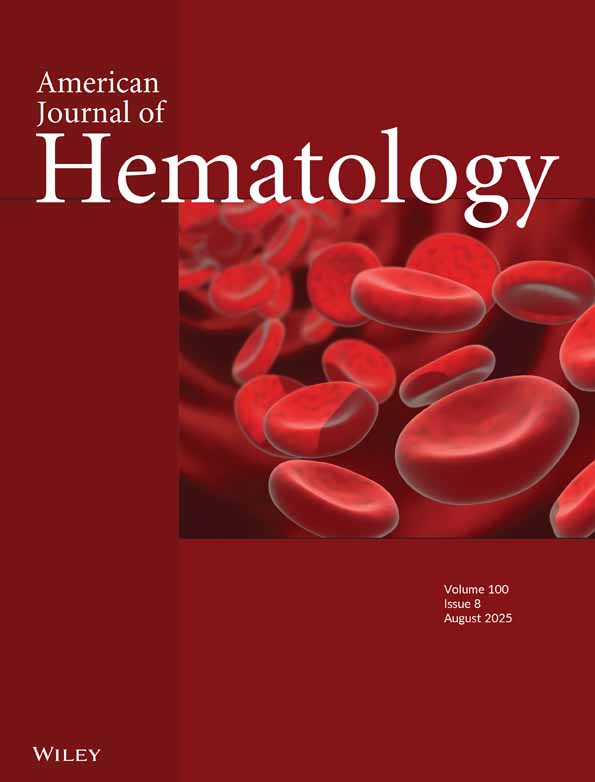Different genotypes are responsible for the normal Russell viper venom assays seen in some cases of congenital factor X deficiency
Antonio Girolami
University of Padua Medical School, Department of Medical and Surgical Sciences, Northeastern Italy Association for the Study of Coagulation Disorders, Padua, Italy
Search for more papers by this authorMargherita Scapin
University of Padua Medical School, Department of Medical and Surgical Sciences, Northeastern Italy Association for the Study of Coagulation Disorders, Padua, Italy
Search for more papers by this authorPamela Scarparo
University of Padua Medical School, Department of Medical and Surgical Sciences, Northeastern Italy Association for the Study of Coagulation Disorders, Padua, Italy
Search for more papers by this authorSilvia Vettore
University of Padua Medical School, Department of Medical and Surgical Sciences, Northeastern Italy Association for the Study of Coagulation Disorders, Padua, Italy
Search for more papers by this authorAntonio Girolami
University of Padua Medical School, Department of Medical and Surgical Sciences, Northeastern Italy Association for the Study of Coagulation Disorders, Padua, Italy
Search for more papers by this authorMargherita Scapin
University of Padua Medical School, Department of Medical and Surgical Sciences, Northeastern Italy Association for the Study of Coagulation Disorders, Padua, Italy
Search for more papers by this authorPamela Scarparo
University of Padua Medical School, Department of Medical and Surgical Sciences, Northeastern Italy Association for the Study of Coagulation Disorders, Padua, Italy
Search for more papers by this authorSilvia Vettore
University of Padua Medical School, Department of Medical and Surgical Sciences, Northeastern Italy Association for the Study of Coagulation Disorders, Padua, Italy
Search for more papers by this author
References
- 1 Girolami A,Scarparo P,Scandellari R,Allemand E. Congenital factor X deficiencies with a defect only or predominantly in the extrinsic or in the intrinsic system: A critical evaluation. Am J Hematol, 2008; 83: 668–671.
- 2 Girolami A,Molaro G,Lazzarin M, et al. A new congenital haemorrhagic condition due to the presence of an abnormal factor X (factor X Friuli). A study of large kindred. Br J Haematol 1970; 19: 179–192.
- 3 Cooper DN,Millar DS,Wacey A, et al. Inherited factor X deficiency: Molecular genetics and pathophysiology. Thromb Haemost 1997; 78: 161–172.
- 4 Uprichard J,Perry DJ. Factor X deficiency. Blood Rev 2002; 16: 97–110.
- 5 MacFarlane RG. Hemostasis. In: R Biggs, editor. Human Blood Coagulation, Hemostasis and Thrombosis. Oxford: Blackwell Scientific Publications; 1972. pp 543.
- 6 Bertina RM,Alderkamp GJ,de Nogy E. A variant of factor X that is defective only in extrinsic coagulation. Thromb Haemost 1981; 46: 88a.
- 7
De Stefano V,Leone G,Ferrelli R, et al.
Factor X Roma: A congenital factor X variant defective at different degrees in the intrinsic and extrinsic activation.
Br J Haematol
1998;
69:
387–391.
10.1111/j.1365-2141.1988.tb02378.x Google Scholar
- 8 Forberg E,Huhmann I,Jimenez-Boj E,Watzke HH. The impact of Glu102Lys on the factor X function in a patient with a doubly homozygous factor X deficiency (Gla14Lys and Glu102Lys). Thromb Haemost 2000; 85: 234–238.
- 9 Girolami A,Vicariotto M,Ruzza G, et al. Factor X Padua: A new congenital factor X abnormality. Acta Haematol 1985; 73: 31–36.
- 10 Girolami A,Vianello F,Cabrio L,Lombardi AM. A new mutation (Arg251Trp) in the Ca2+ binding site of factor X protease domain appears to be responsible for the defect in the extrinsic pathway activation of factor X Padua. Clin Appl Thromb Haemost 2004; 10: 5–8.
- 11 James HL,Girolami A,Fair DS. Molecular defect in coagulation factor X Friuli results from a substitution of Serine for Proline at position 343. Blood 1991; 77: 317–323.
- 12 Nora RE,Bell WR,Noe DA,Sholar PW. Normal partial thromboplastin time and associated spindle cell thymoma. Ann J Med 1985; 79: 122–126.
- 13 Odom MW,Leone G,De Stefano V, et al. Five novel point mutations: Two causing haemophilia B and three causing factor X deficiency. Mol Cell Probes 1994; 8: 63–65.
- 14 Parkin JD,Madaras F,Sweet B,Castaldi PA. A further inherited variant of coagulation factor X. Aust N Z J Med 1974; 4: 561–564.
- 15 Pinotti M,Marchetti G,Baroni M, et al. Reduced activation of the Gla19Ala FX variant via the extrinsic coagulation pathway results in symptomatic CRMred FX deficiency. Thromb Haemost 2002; 88: 236–241.
- 16 Simioni P,Vianello F,Kalafatis M, et al. A dysfunctional factor X (factor X San Giovanni Rotondo) present at homozygous and double heterozygous level: Identification of a novel microdeletion (delC556) and missense mutation (Lys(408)–>Asn) in the factor X gene. A study of an Italian family. Thromb Res 2001; 101: 219–230.
- 17 Sun P,Hata J,Bauer J,Haibach C, et al. A functional factor X deficiency. Am J Haematol 1995; 48: 1–4.
- 18 Watzke HH,Lechner K,Roberts HR, et al. Molecular defect (Gla+14-Lys) and its functional consequences in a hereditary factor X deficiency (factor X “Vorarlberg”). J Biol Chem 1990; 265: 11982–11989.
- 19 Bezeaud A,Miyata T,Helley D, et al. Functional consequences of the Ser 334—Pro mutation in a human factor X variant (factor X Marseille). Eur J Biochem 1995; 234: 140–147.




